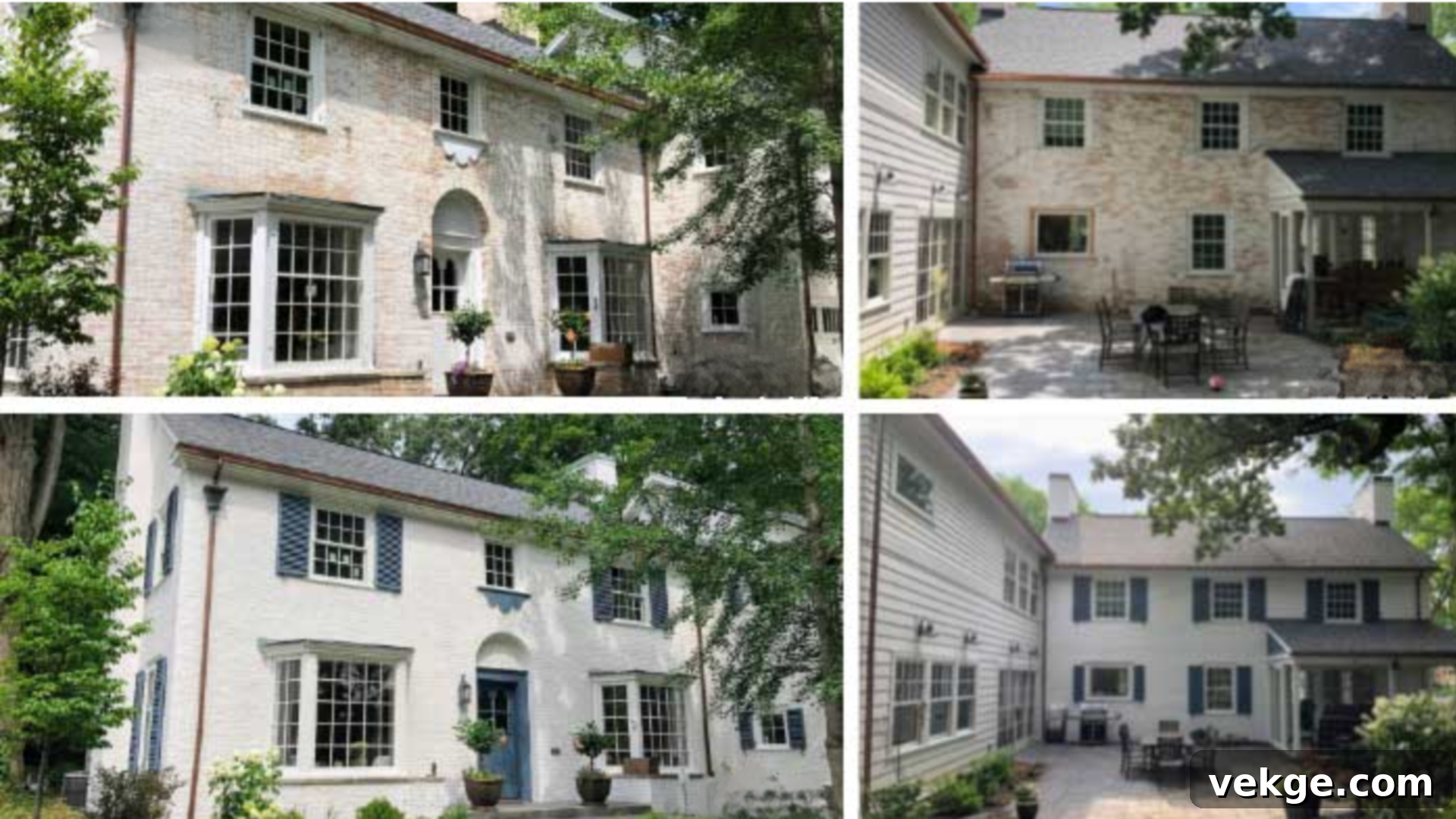Unveiling the Power of Paint: Stunning Painted Brick House Before & After Transformations
Have you ever considered painting your brick house but felt unsure about where to begin? Many homeowners face this dilemma, but once you witness the incredible impact a fresh coat of paint can have, there’s no turning back. Painting brick isn’t just about changing a color; it’s about reimagining your home’s entire aesthetic and significantly boosting its curb appeal.
Altering your brick exterior’s color can completely revitalize your property, giving it a modern, classic, or even bold new identity. The right shade has the power to breathe new life into your home’s exterior, reflecting your personal style and enhancing its architectural features. From drab to dramatic, the transformation can be truly astonishing, making your house stand out in the neighborhood.
In this comprehensive guide, focusing on captivating painted brick houses before and after, we’ll delve into a world of inspiring makeovers. You’ll discover how to confidently choose the perfect color palette that complements your home’s unique character and learn the precise steps involved in the painting process. We’ll cover everything from initial preparation to the final brushstroke, ensuring a professional and durable finish.
Beyond the aesthetic choices, this guide also provides practical insights into whether to tackle the project yourself or hire a seasoned professional. We’ll also equip you with essential knowledge to avoid common pitfalls, saving you time, money, and potential headaches. Get ready to embark on a transformative journey for your brick home – let’s explore the endless possibilities!
Painted Brick Houses Before-and-After Makeover Ideas to Inspire Your Home Transformation
The color of your brick home is a cornerstone of its overall appearance. A strategic paint job can dramatically update its look, adding value and a fresh, contemporary feel. If you’re seeking inspiration for painted brick house ideas, these before-and-after color upgrades for brick exteriors showcase the profound impact a simple color change can achieve.
1. Red Brick to White: A Timeless and Bright Update
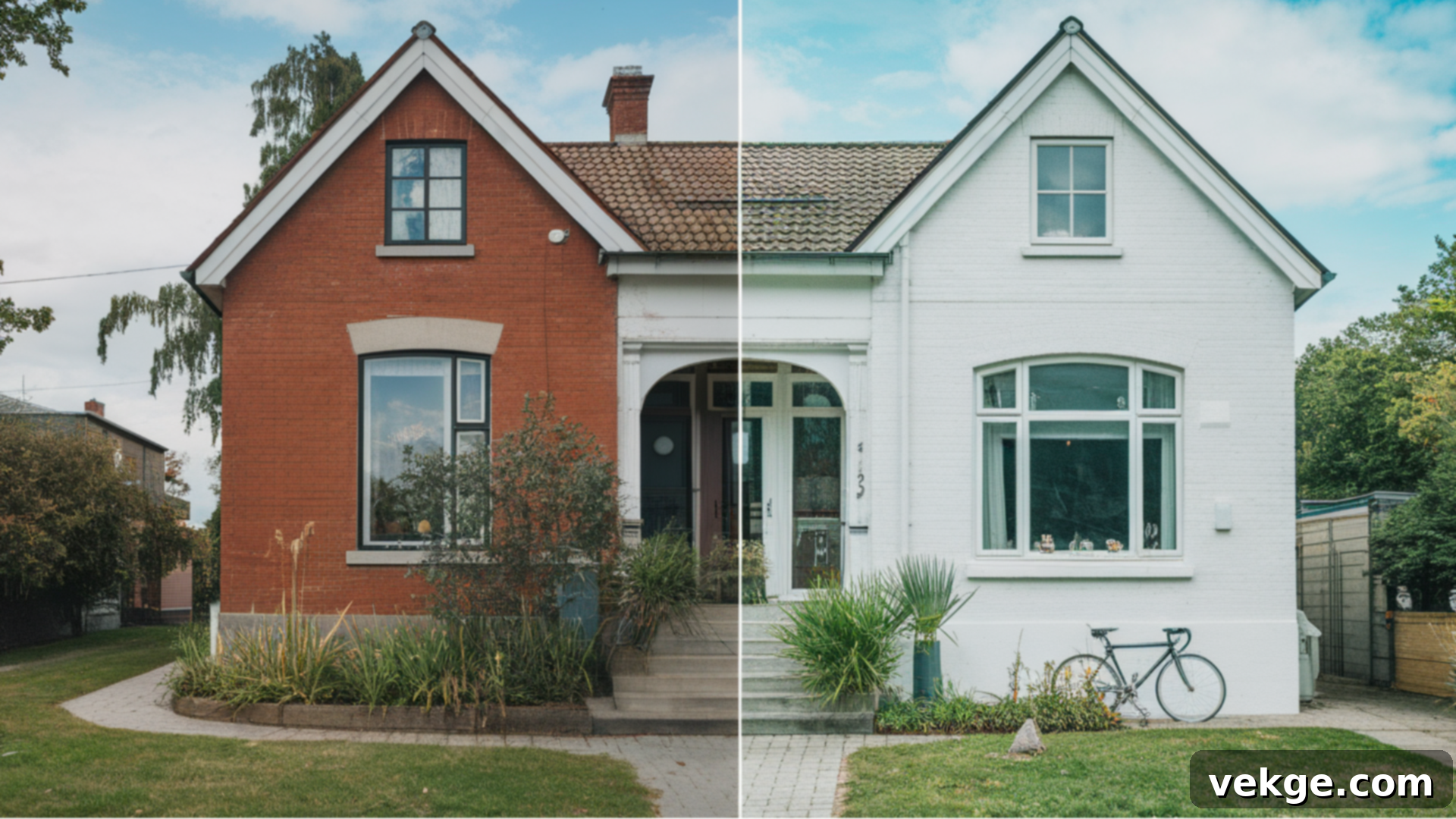
Transforming a classic red brick facade to a pristine white immediately brightens the entire home, imparting a crisp, clean, and utterly fresh aesthetic. This popular choice visually expands the perception of space, making the house appear larger and more inviting. White paint also effortlessly introduces a modern touch, creating a contemporary yet timeless appeal that pairs beautifully with almost any landscaping or trim color.
2. Brown Brick to Light Gray: Sophistication with a Subtle Shift
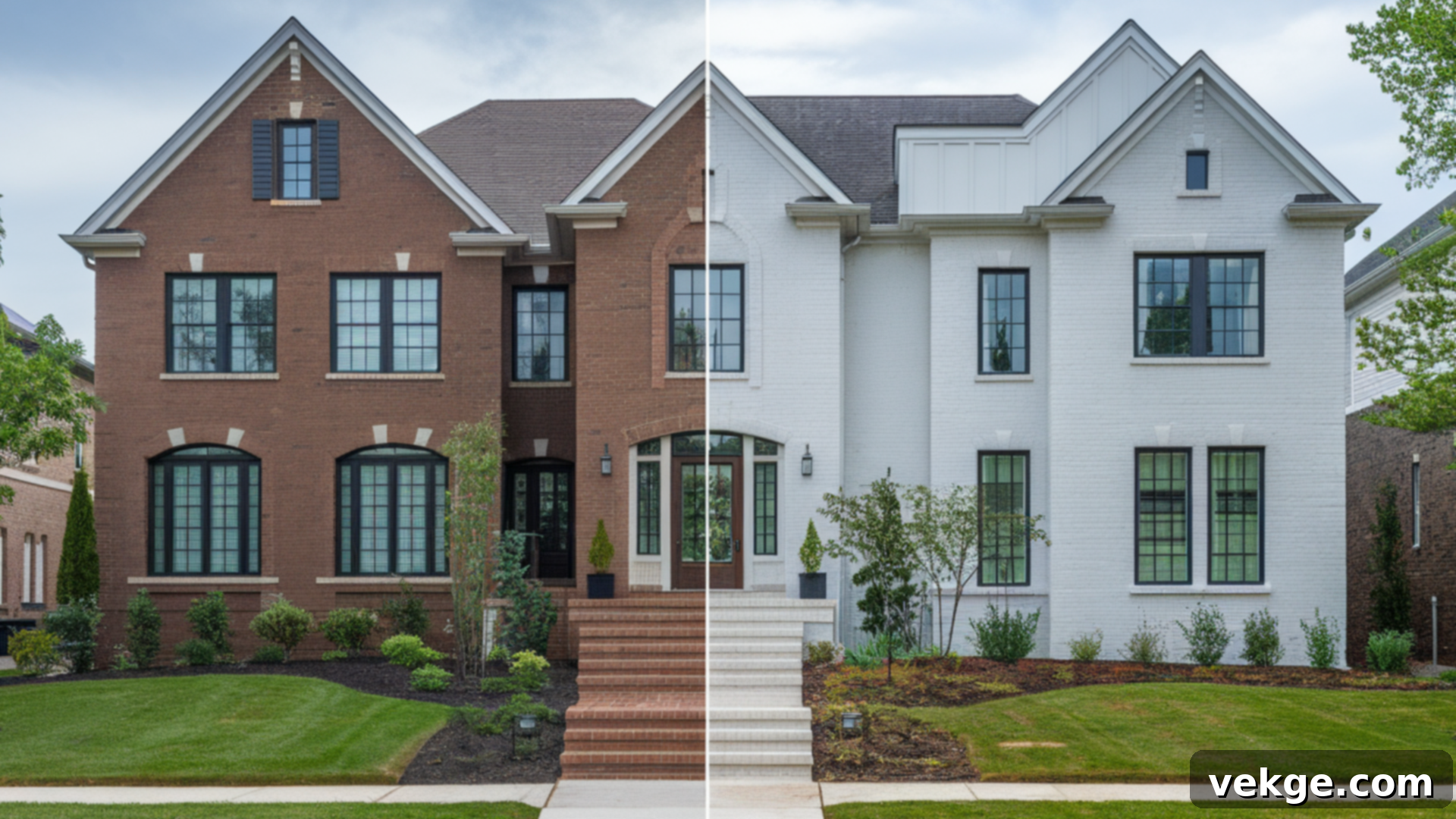
A transition from brown brick to light gray offers a refined and subtle update. This neutral hue softens the often strong presence of brown brick, imbuing the home with an air of sophistication. Light gray maintains a grounded feel while being versatile enough to complement both modern architectural lines and more classic designs, providing a chic and enduring exterior.
3. Orange Brick to Black: Bold, Urban, and Chic

For those seeking a dramatic and impactful change, painting orange brick black delivers a bold, urban edge. The deep, rich black creates a striking contrast, especially when paired with crisp white or light-colored trim, resulting in a sleek, contemporary, and undeniably sophisticated exterior. This choice makes a strong architectural statement.
4. Red Brick to Charcoal Gray: Modern Elegance
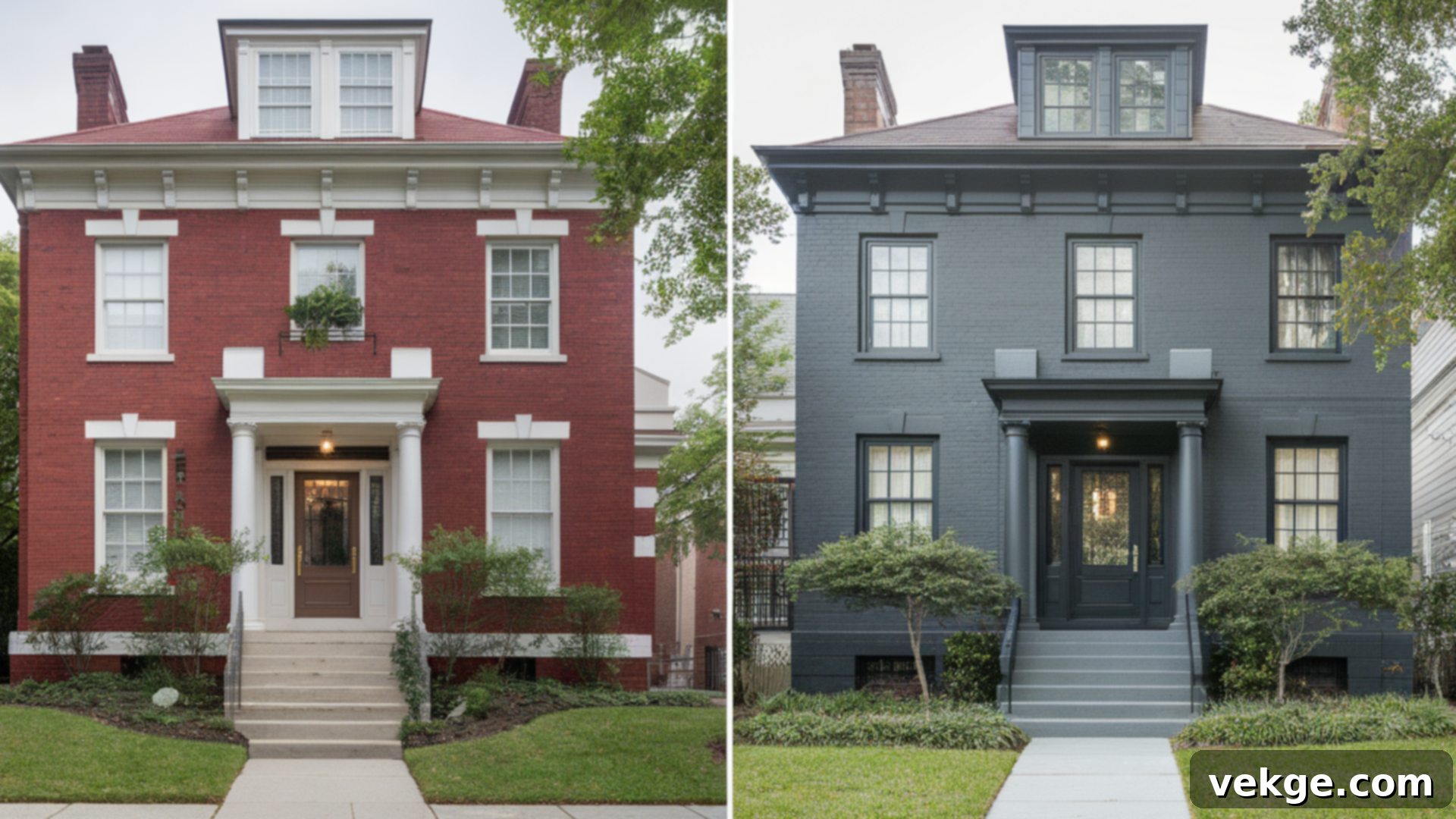
A deep charcoal gray offers a sleek, refined, and sophisticated upgrade for traditional red brick. This darker tone provides a strong visual anchor for the home, beautifully complementing white trim or elegant brass accents. It’s an excellent choice for homeowners looking for a modern update that still maintains a sense of classic gravitas and works exceptionally well with various contemporary architectural elements.
5. Tan Brick to Sage Green: Natural Harmony
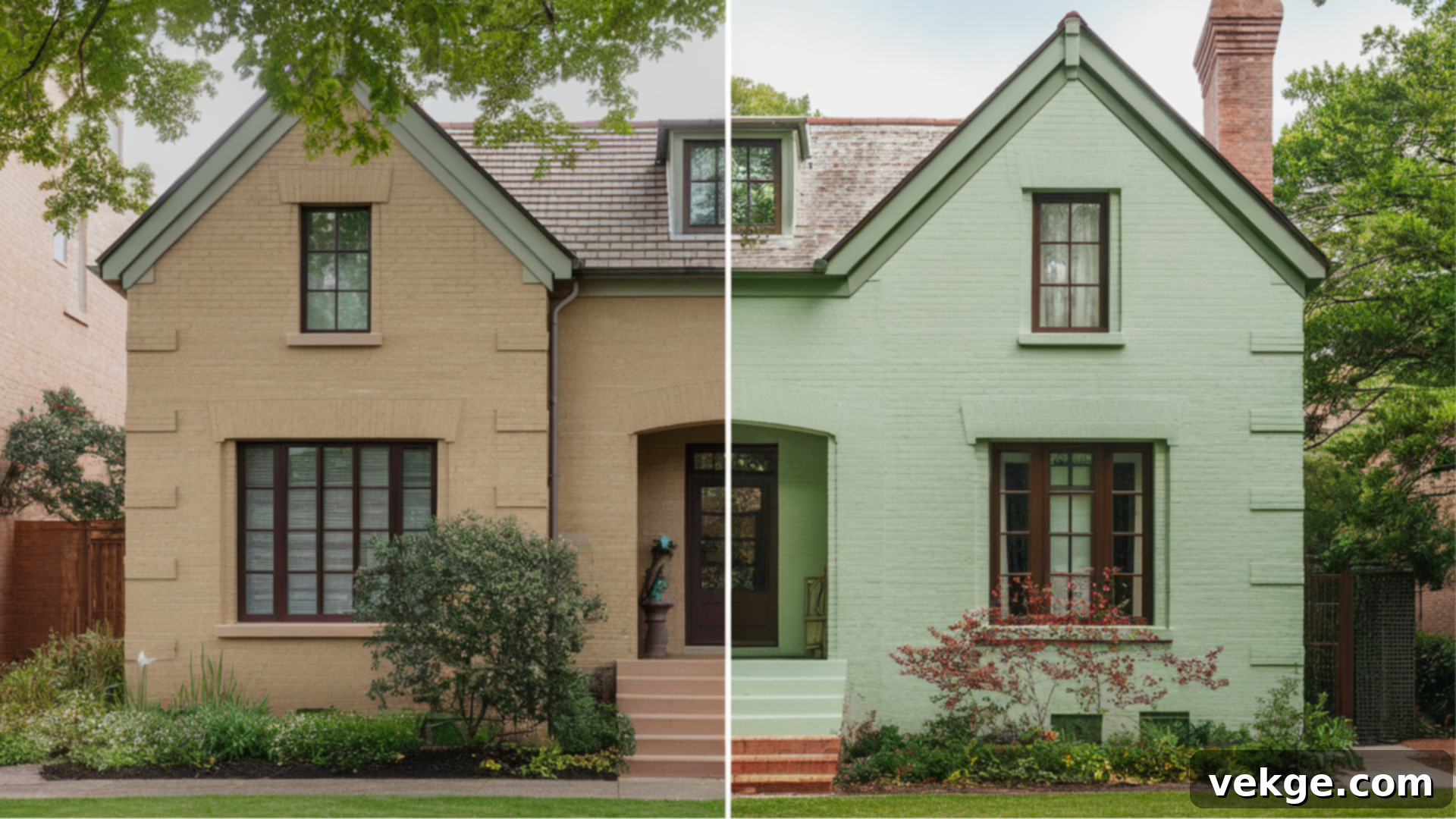
Transitioning from tan brick to a soothing sage green introduces a warm, earthy, and organic vibe. This natural hue blends effortlessly with lush gardens, mature trees, and natural landscapes, creating a harmonious and tranquil home exterior. Sage green evokes a sense of calm and welcome, perfect for homes nestled in green surroundings or those aiming for a charming, rustic modern aesthetic.
6. Red Brick to Soft Beige: Inviting and Versatile
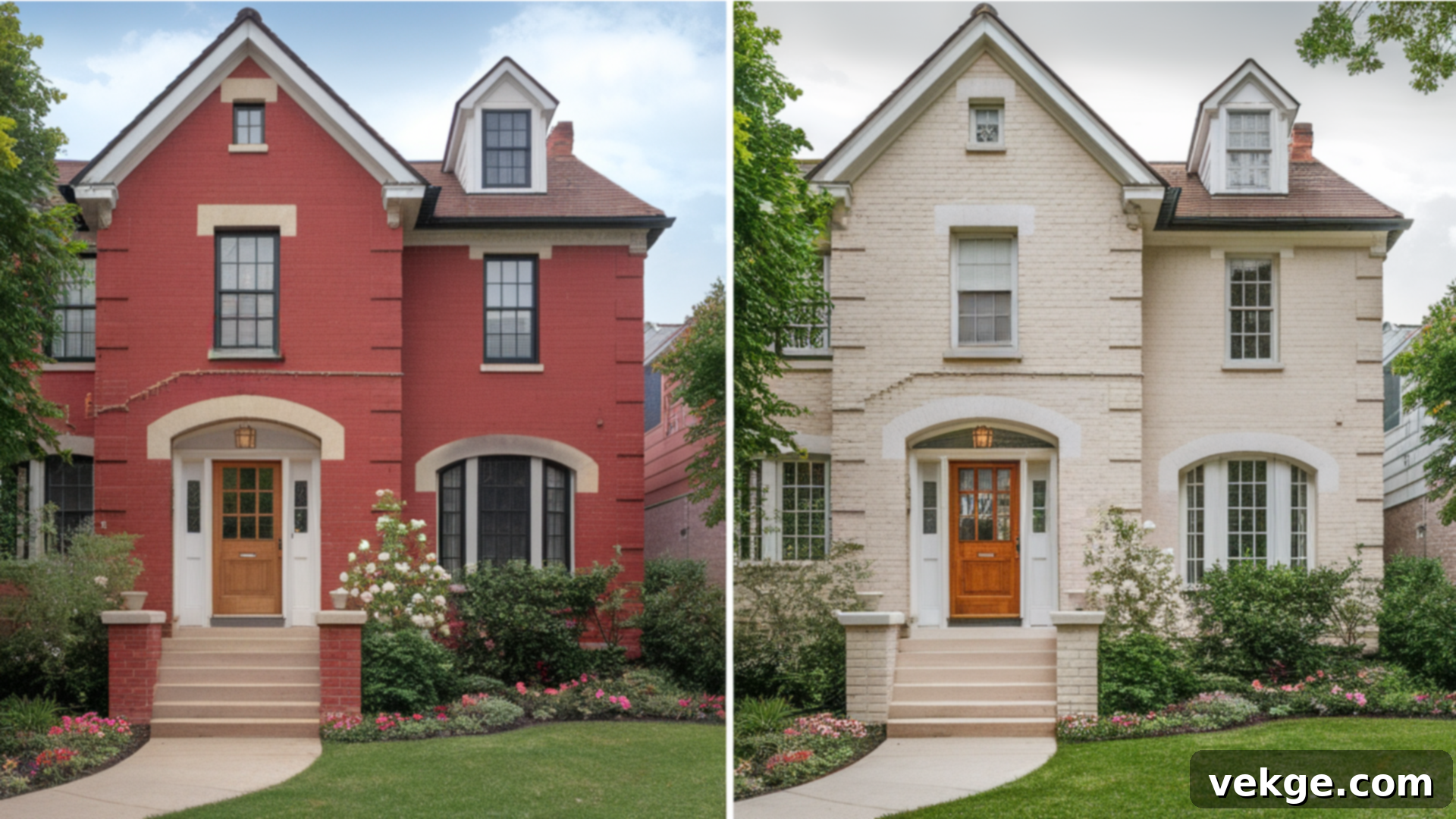
For red brick, a soft beige offers a lighter, warmer, and incredibly inviting feel. This neutral shade strikes a perfect balance between cozy comfort and understated style, making it a highly versatile choice that complements a wide array of architectural styles, from traditional to transitional. It provides a welcoming backdrop for various landscaping elements and exterior decorations.
7. Brown Brick to Navy Blue: Bold Contrast with Calm Authority
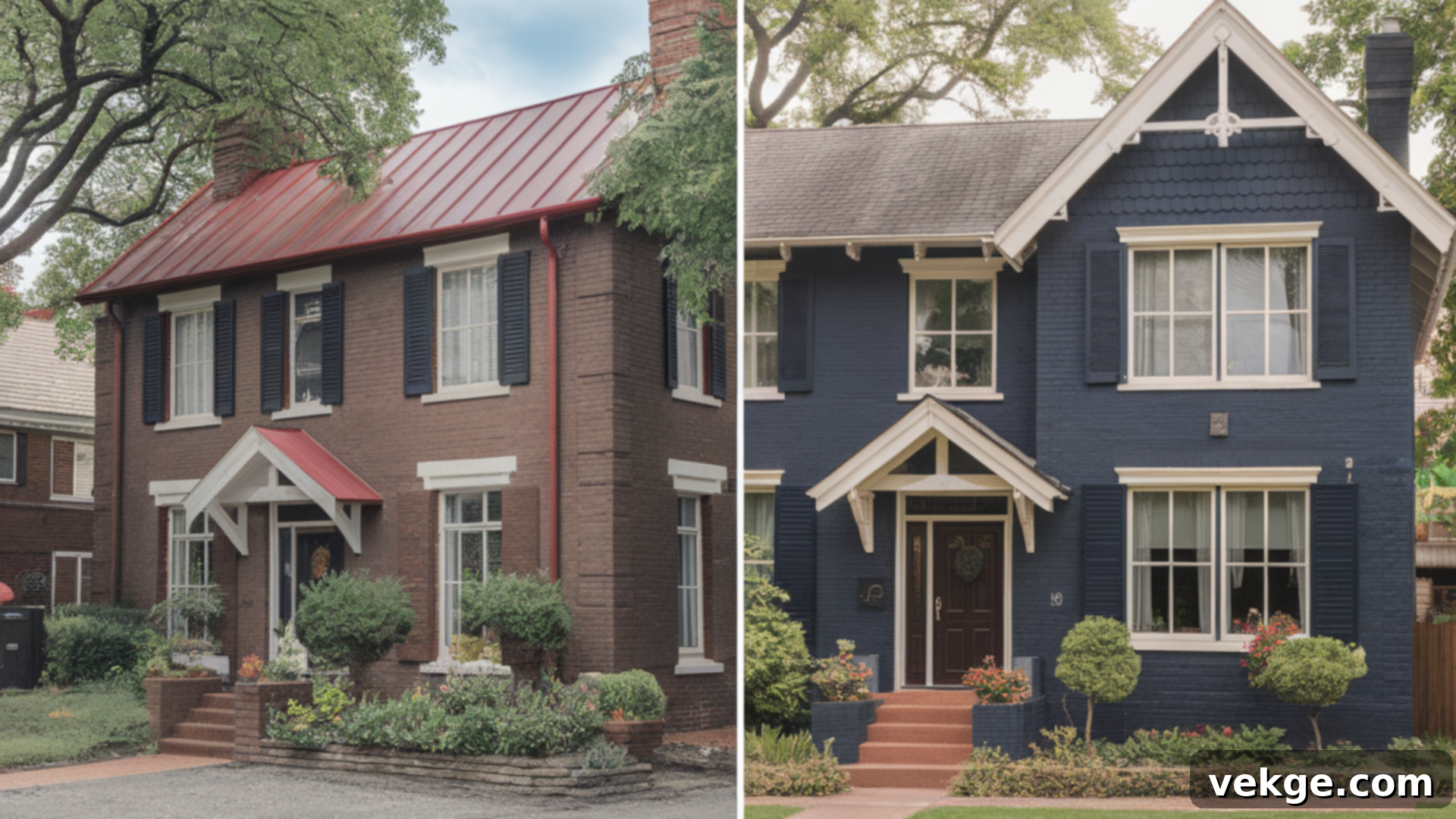
A striking transformation from brown brick to navy blue introduces a sense of authority and calm to the home’s exterior. This deep, sophisticated hue offers a bold yet classic contrast, adding significant visual depth and character. It creates a distinguished and stylish presence that is both welcoming and commands attention, especially when accented with crisp white or natural wood elements.
8. Light Brown Brick to Warm Taupe: Earthy and Relaxed
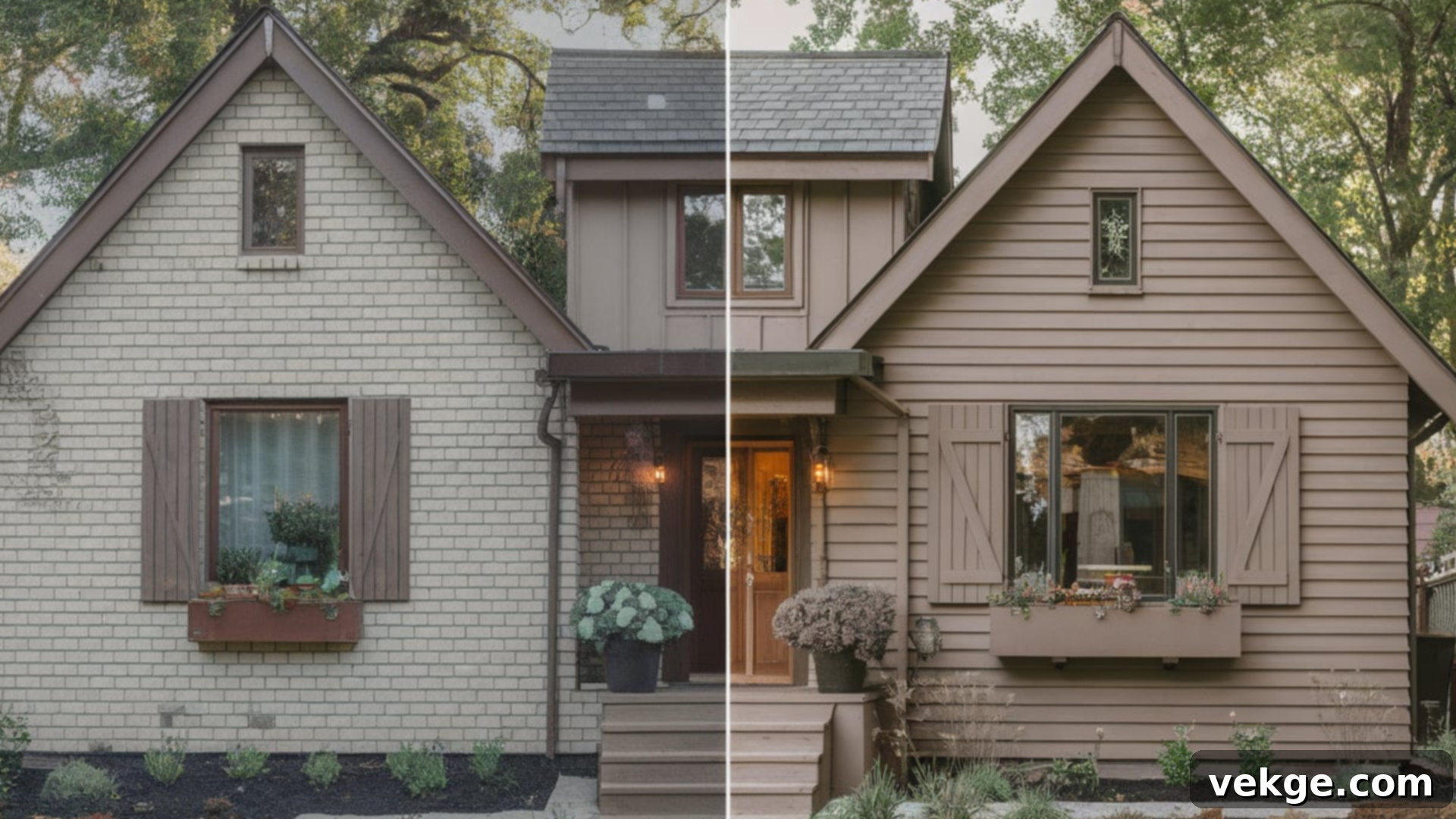
A warm taupe complements light brown brick beautifully, creating an instantly earthy and relaxed ambiance. This sophisticated neutral shade pairs perfectly with wooden accents, natural stone, or lush greenery, upgrading the home’s inherent beauty with a contemporary yet cozy appeal. It’s an ideal choice for a serene, grounded exterior that feels inviting and chic.
9. Red Brick to Soft White with Black Trim: Classic Modern Contrast
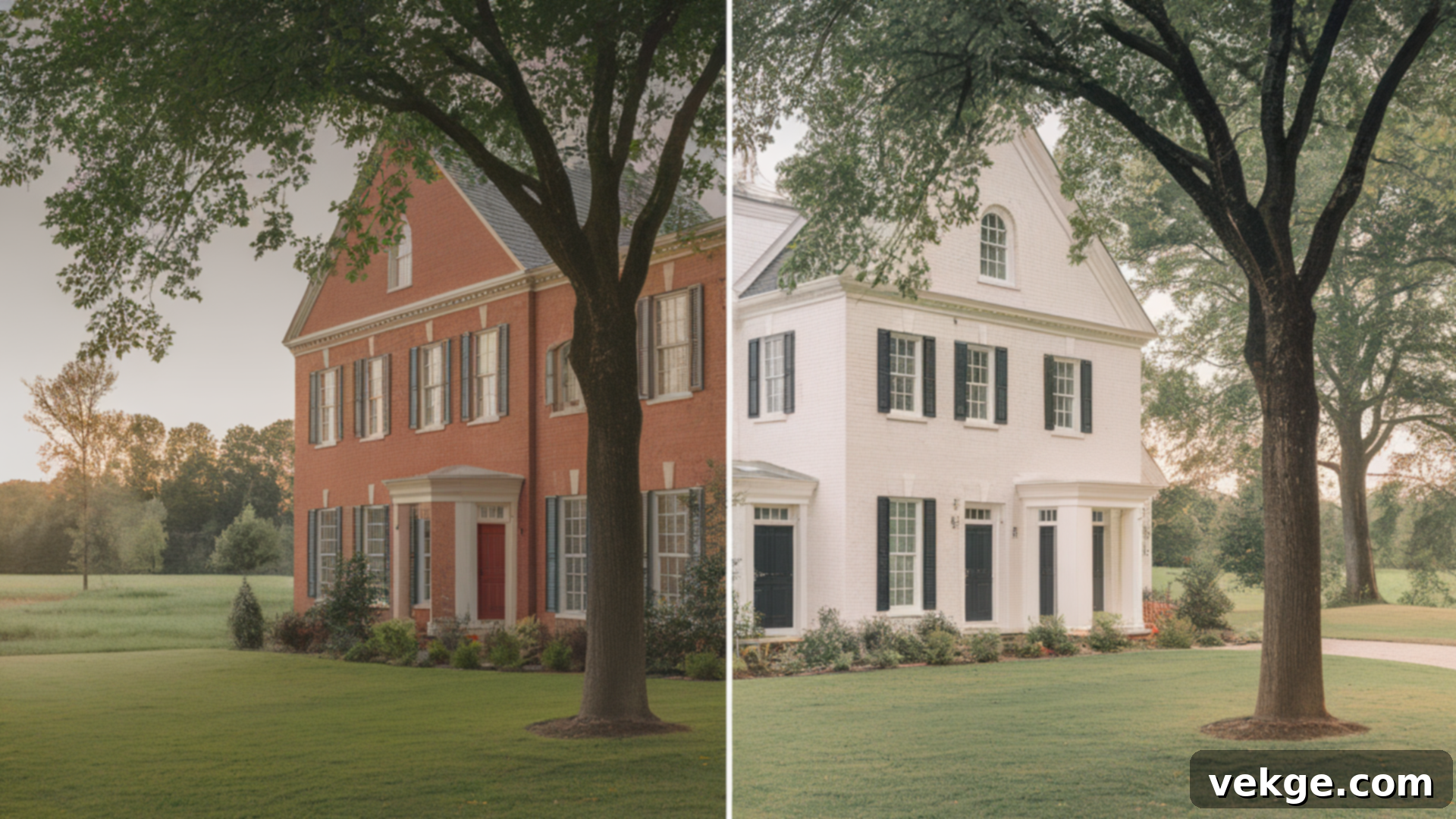
A sophisticated pairing of soft white with crisp black trim creates a truly striking and timeless look for a red brick home. This classic contrast not only highlights the home’s architectural features but also lends it a clean, polished, and distinctly modern appeal. The combination is a staple in contemporary design, offering both elegance and a strong visual statement.
10. Orange Brick to Dusty Blue: Vintage Charm and Serenity
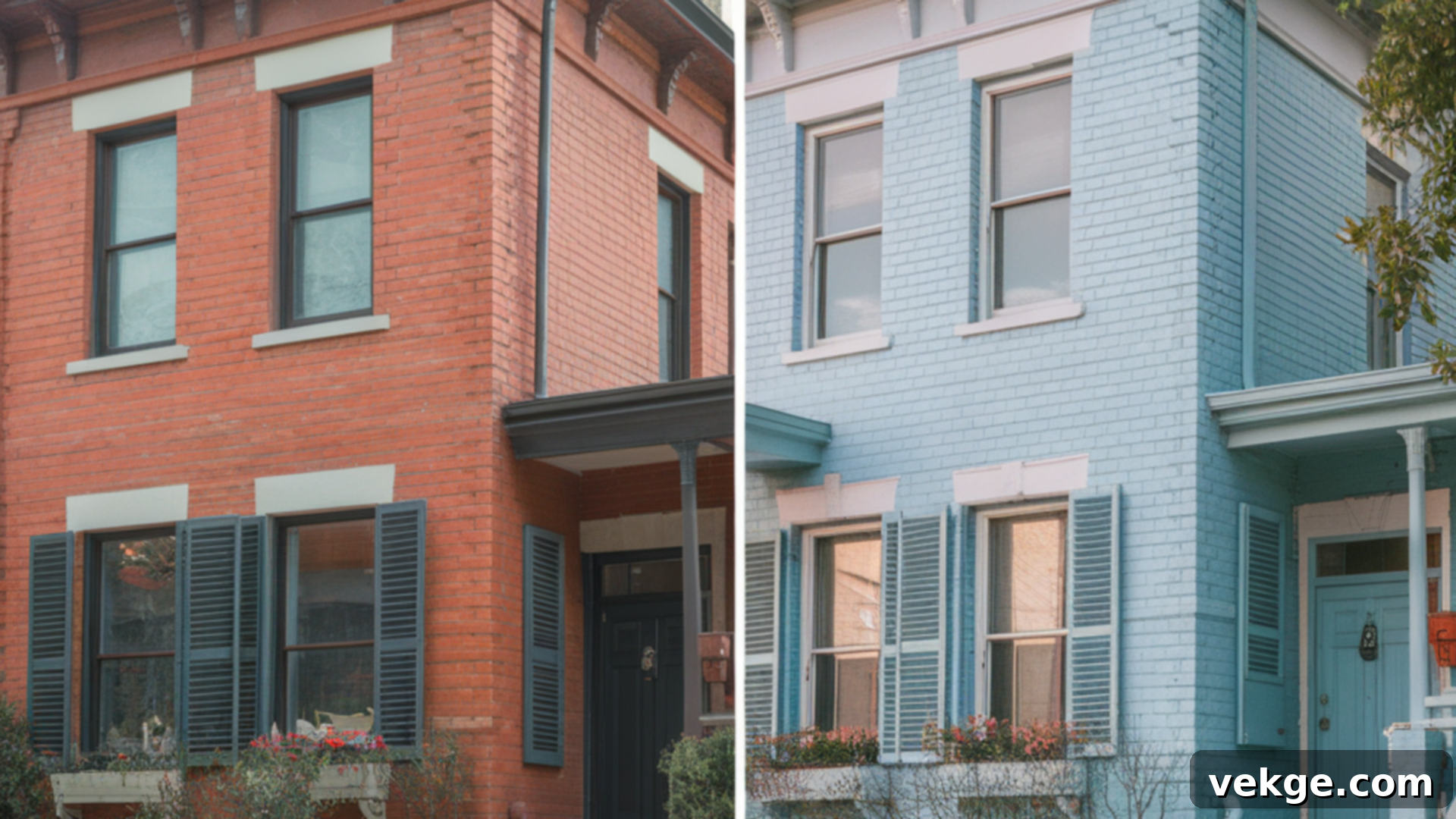
Transforming warm orange brick to a muted, dusty blue provides a cool, inviting, and unexpectedly charming contrast. This delicate hue adds a touch of vintage appeal and serene tranquility to the home, creating an exterior that feels both cozy and distinctively welcoming. It’s an excellent choice for homeowners seeking a unique look with a calming ambiance.
11. Red Brick to Pale Mint Green: Fresh and Peaceful
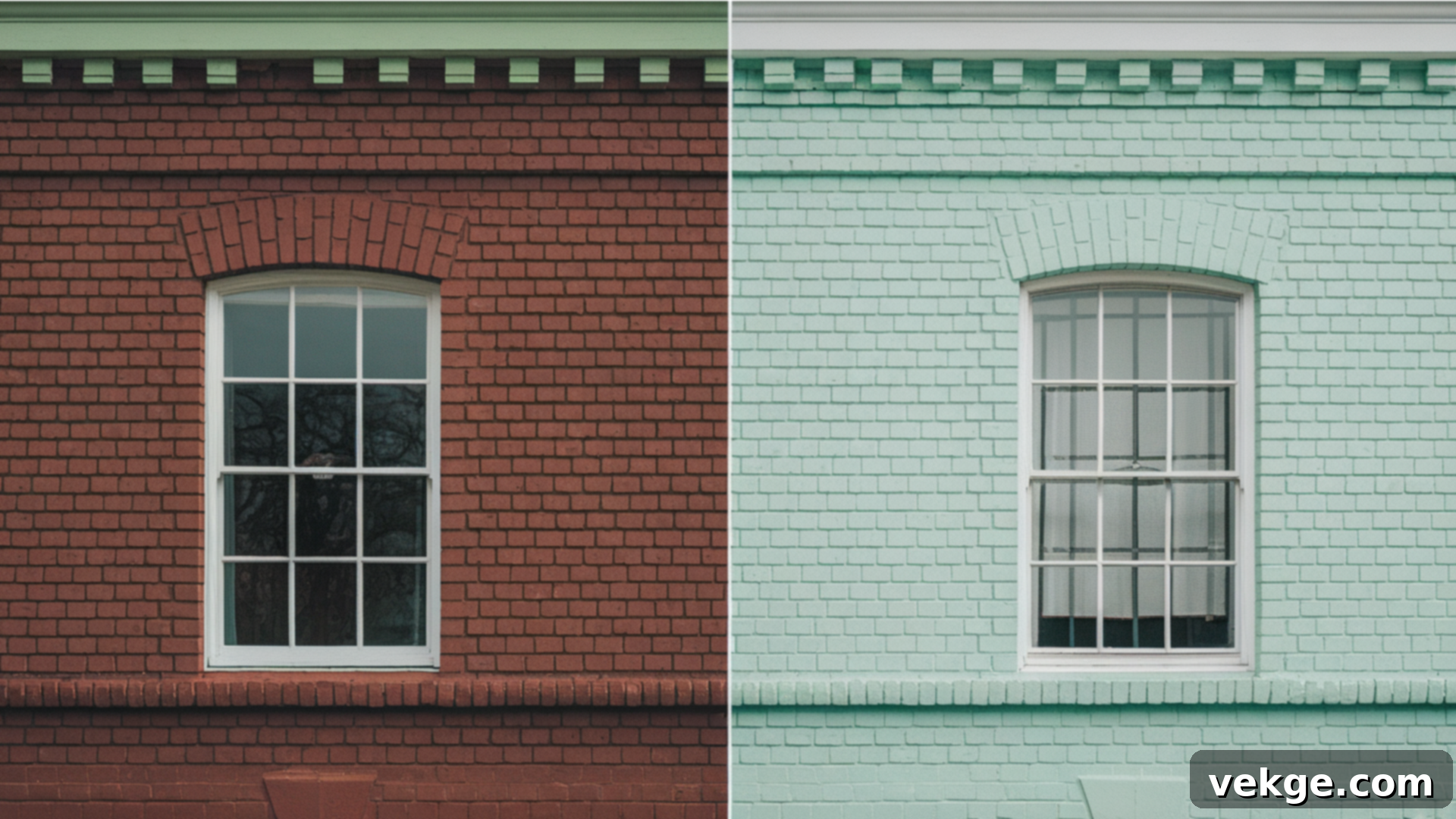
A pale mint green offers a subtle yet refreshing change for red brick, imbuing the exterior with a peaceful and inviting ambiance. This gentle, cool hue creates a harmonious and classic appearance, especially when complemented by natural wood or white trim. It’s a fantastic choice for homes seeking a soft, welcoming look that feels connected to nature.
12. Brown Brick to Matte Black with Brass Accents: Modern Industrial Luxury

Transforming brown brick to a sleek matte black paired with strategic brass accents creates a striking modern industrial feel with an undeniable touch of luxury. The dark, sophisticated base highlights the warmth and sheen of brass fixtures, giving the home a contemporary, edgy, and highly refined appearance. This combination is perfect for those seeking a bold, high-design exterior.
13. Light Gray Brick to Bright White with Wooden Accents: Clean, Airy, and Warm
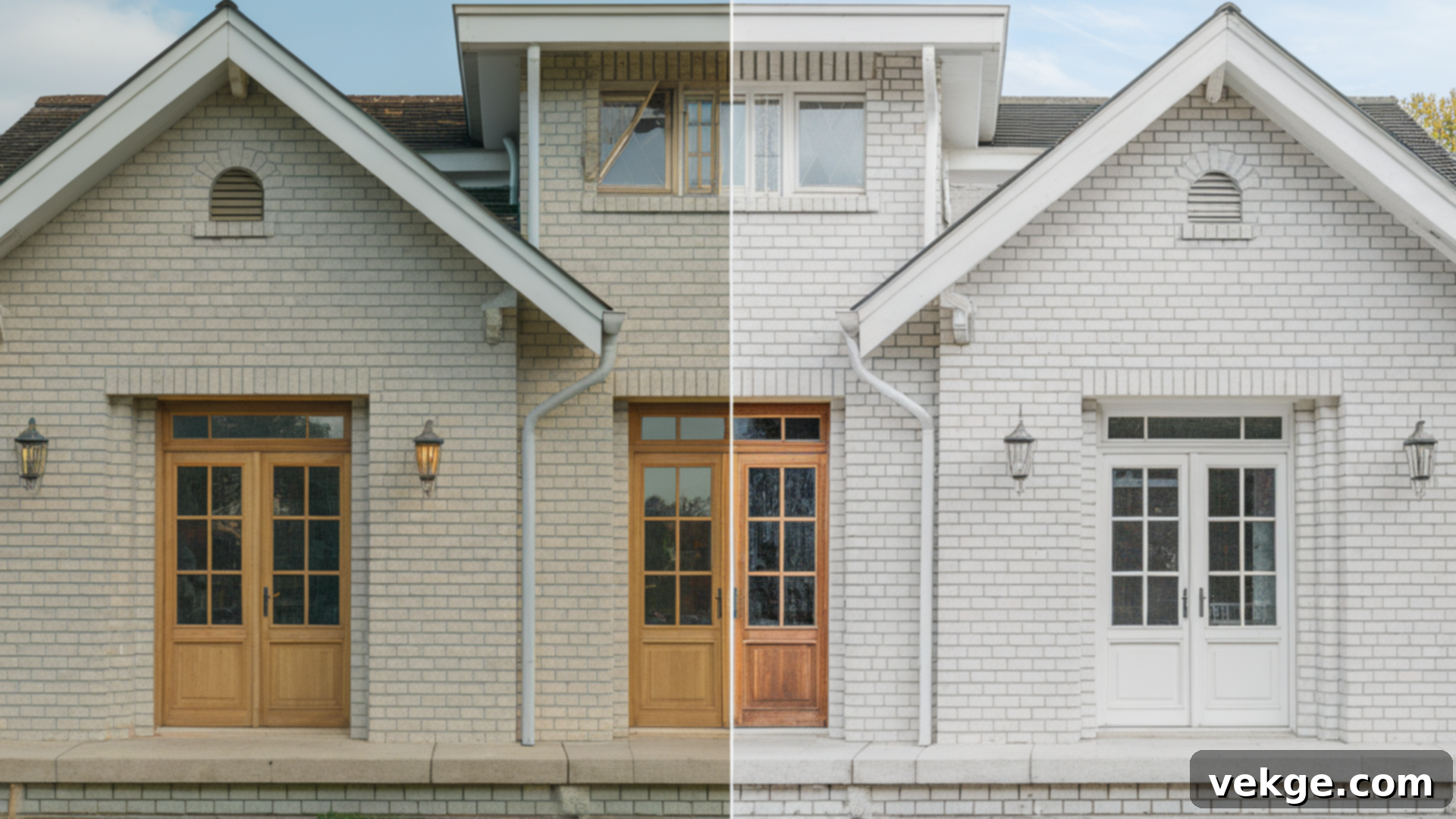
For light gray brick, a bright white palette complemented by warm wooden accents creates an exquisitely clean, airy, and inviting natural look. The crisp white emphasizes architectural lines, giving the home a fresh, modern appeal, while the contrasting light wood introduces essential warmth and organic texture. This combination is ideal for a contemporary, Scandinavian-inspired, or minimalist aesthetic.
14. Red Brick to Light Olive Green: Rustic and Inviting
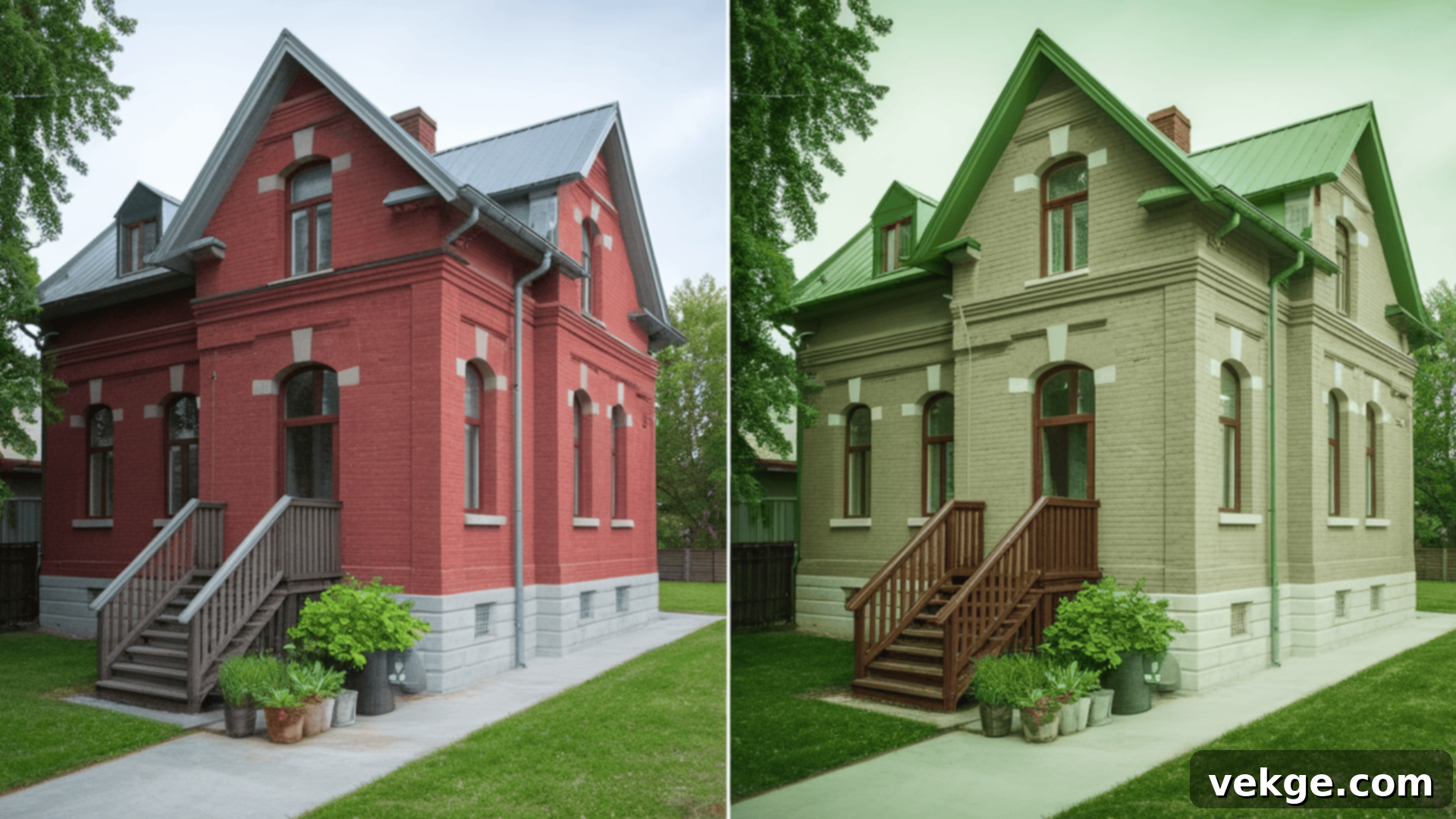
A light olive green bestows a charming rustic and earthy appeal upon red brick. This soft, natural color beautifully integrates with the surrounding landscape, creating a calm, harmonious, and profoundly inviting atmosphere for the exterior. It’s a wonderful choice for homes seeking a connection to nature, exuding a quiet elegance and timeless appeal.
15. Red Brick to Soft Lavender: Whimsical and Unique Charm
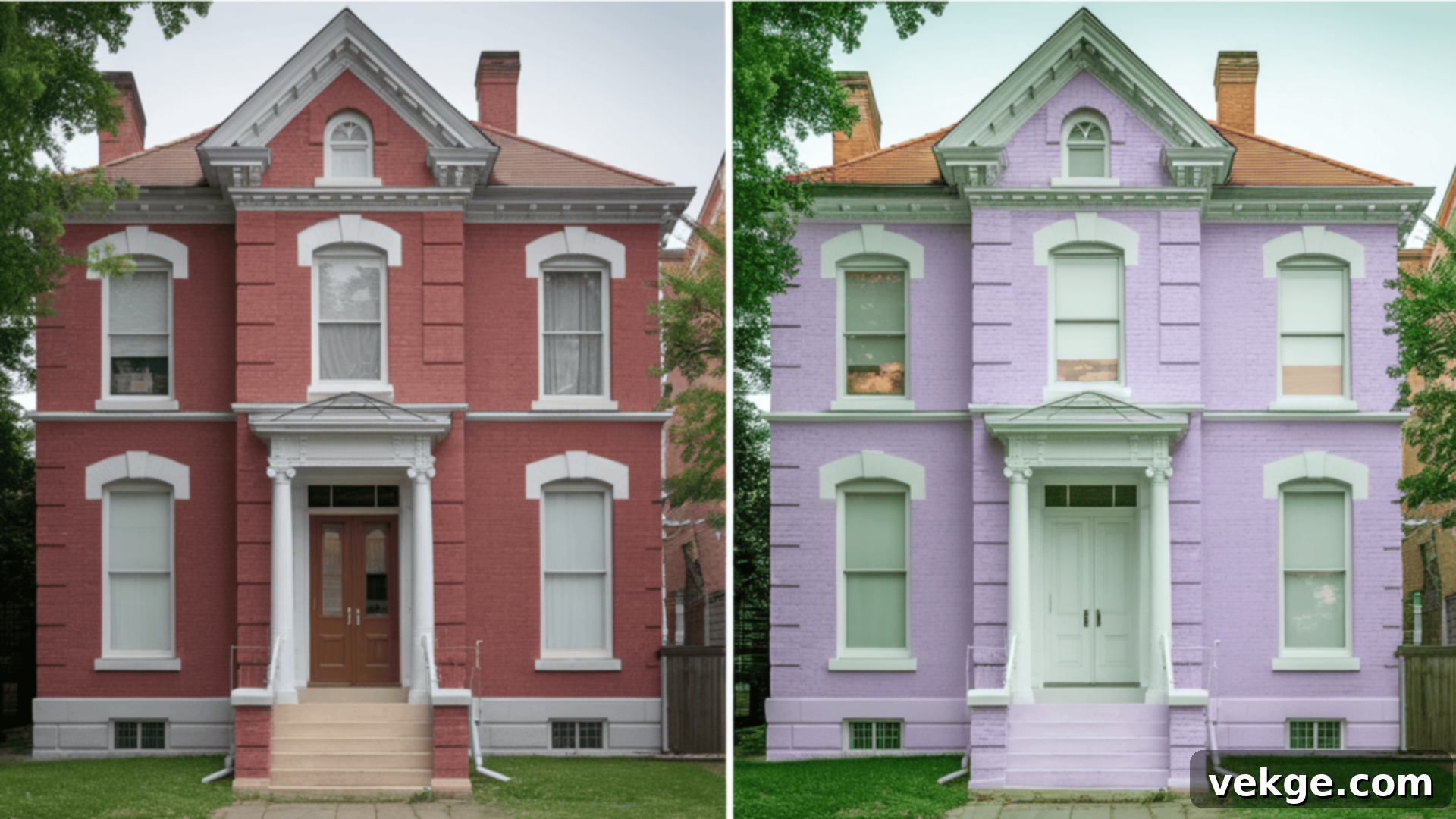
For those daring to be different, transforming red brick to soft lavender introduces a delightful whimsical and romantic touch. This delicate, unexpected hue sets the home apart with its unique charm, creating a warm, welcoming, and memorable atmosphere. It’s an artistic choice that evokes a sense of individuality and playful elegance.
16. Brown Brick to Earthy Sandstone: Naturally Inviting
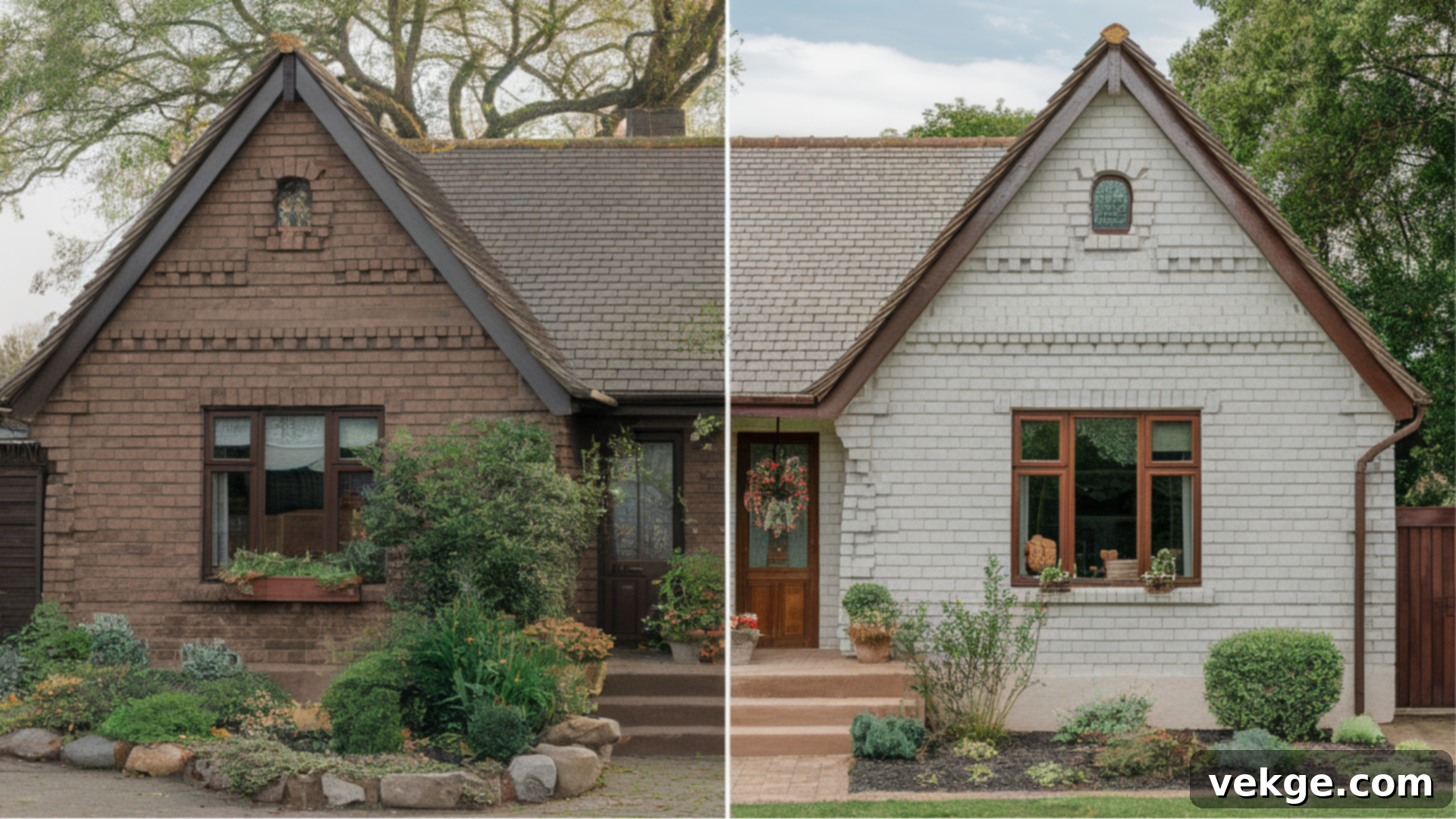
Shifting from brown brick to earthy sandstone tones offers a neutral, warm, and highly appealing update. This subtle yet impactful change enhances the home’s natural beauty, creating a welcoming, grounded feel that effortlessly complements a wide range of architectural styles and outdoor settings. It’s a timeless choice that feels organic and sophisticated.
17. Gray Brick to Bright White with Light Wood: Contemporary and Fresh
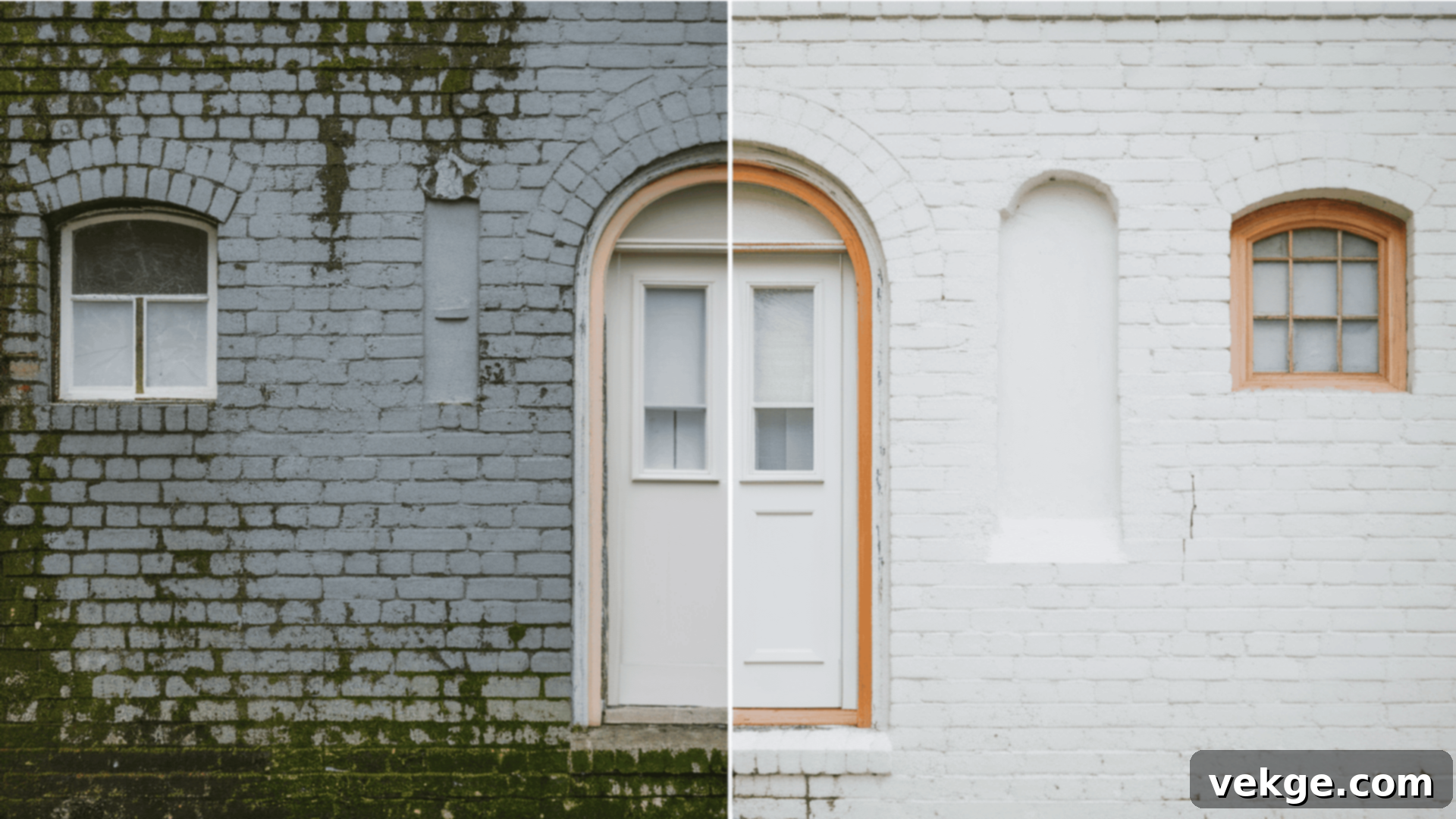
A bright white palette combined with complementary light wood accents creates a wonderfully clean, airy, and contemporary vibe for gray brick. This winning combination elevates the architectural lines, infusing the home with a fresh, modern appearance while introducing natural warmth and inviting texture. It’s an ideal choice for a sophisticated, minimalist, or Nordic-inspired exterior.
Choosing the Right Color for Your Brick House: A Strategic Decision
Selecting the ideal paint color for your brick exterior is a crucial step that goes beyond mere aesthetics. It’s key to enhancing your home’s architectural style, significantly boosting its curb appeal, and potentially increasing its property value. When exploring exterior brick paint color ideas, consider not just your personal preferences, but also your home’s fixed elements (roof, existing trim, landscaping) and its surroundings. Here are some popular and effective options to help you choose the right one for your space:
- White: A perennially popular choice, white brightens the home dramatically, making it appear larger, more inviting, and undeniably fresh. It offers a classic, timeless appeal that works with almost any architectural style. However, its pristine nature means it shows dirt and grime more readily, requiring more frequent maintenance and cleaning to retain its immaculate look.
- Gray: Gray offers a modern, sophisticated, and refined look that can camouflage dirt and imperfections better than pure white. Its versatility allows it to pair well with both warm wood accents and cool metal finishes. However, the wrong shade of gray can sometimes feel cold or uninviting, especially in certain lighting conditions, and trends in gray can shift, potentially dating your home if not chosen carefully.
- Black: For a bold and dramatic statement, black creates an undeniably striking, upscale appearance. It offers powerful contrast, especially when paired with light trim, and imparts a contemporary, strong presence. Be mindful that dark colors absorb more heat, which can impact interior temperatures and potentially the longevity of the paint in very sunny climates. Careful coordination with other exterior elements is essential to avoid an overly harsh look.
- Off-White: Offering a softer alternative to stark white, off-white hues provide a warm, inviting, and bright tone, making them perfect for traditional, farmhouse, or coastal styles. They maintain brightness without the starkness. The challenge lies in ensuring proper maintenance, as off-whites can appear dingy if neglected, and choosing the right undertone to prevent clashing with cool-toned accents or existing elements.
- Earthy Tones (e.g., Taupe, Sage Green, Sandstone): These organic colors blend seamlessly with natural surroundings, creating a calming, grounded, and harmonious effect. They are highly adaptable and suit various home styles, from rustic to contemporary. While offering natural beauty, some earthy tones can appear dull or muted in overcast weather or low light, so it’s important to test swatches in different lighting conditions.
- Monochromatic Color Schemes: Utilizing varying shades of a single color creates a sleek, cohesive, and sophisticated appearance, often favored in modern architectural designs. This approach emphasizes texture and form. However, achieving balance is key; without careful accent planning through landscaping, materials, or subtle trim colors, a monochromatic scheme can risk appearing monotonous or lacking depth.
Each color palette brings distinct advantages and unique challenges. When making your final decision, consider your home’s unique architectural period, the amount of natural light it receives, your local climate, any HOA guidelines, and most importantly, your personal aesthetic vision. Choosing wisely will ensure your painted brick exterior stands out for all the right reasons.
Step-by-Step Guide for Painting Brick Houses: Achieving a Flawless Finish
Painting brick is a significant home improvement project that requires meticulous preparation and the application of correct techniques to ensure a lasting, professional-grade finish. Rushing any step can compromise the durability and appearance of your newly painted exterior. Follow these detailed steps for success:
Step 1: Thorough Preparation and Strategic Planning
Begin by conducting a comprehensive inspection of your brick for any signs of damage, loose mortar, efflorescence (white powdery deposits), or existing paint issues. Any loose debris, dirt, or old flaky paint must be removed. Power wash the entire brick surface thoroughly to remove all dirt, grime, mold, and mildew. Allow the surface to dry completely for a minimum of 24-48 hours, or even longer in humid conditions. For heavily soiled areas, a bleach-water solution (1 part bleach to 3 parts water) or a trisodium phosphate (TSP) cleaner can be used with a stiff brush, followed by a thorough rinse. Address any repairs by carefully removing loose mortar and filling cracks or spalling with a high-quality masonry patching compound. Allow all repairs to cure fully, typically for at least 24-48 hours, as per product instructions.
Crucially, select an optimal painting day: ensure temperatures are consistently between 50°F and 85°F (10°C and 30°C), with low humidity and absolutely no rain in the forecast for at least 24-48 hours after application. Ideal conditions ensure proper paint adhesion and curing.
Step 2: Priming and Smart Paint Selection
Applying the correct primer is non-negotiable for painted brick. Use a high-quality masonry primer specifically designed for brick. This type of primer is crucial because it’s breathable, allowing moisture vapor to escape from within the brick (preventing bubbling and peeling), and it’s alkali-resistant, which protects against the alkalinity of mortar that can otherwise break down paint over time. Ensure the primer provides complete, even coverage over the entire brick surface.
For the topcoat, choose a breathable masonry paint. Excellent options include mineral-based paints (like limewash or silicate paints, which deeply bond with masonry), high-quality 100% acrylic latex paints (known for their flexibility and durability), or elastomeric coatings (which offer superior waterproofing and crack-bridging properties, ideal for older or more porous brick). Avoid using standard exterior house paint, which can trap moisture and lead to failures.
Select a finish that aligns with your aesthetic and practical needs:
- Matte: Best for hiding surface imperfections and providing a subtle, sophisticated look.
- Satin: Offers a slight sheen, is easier to clean than matte, and provides a balanced aesthetic.
- Eggshell: A popular choice for its low-sheen durability, balancing appearance and maintenance.
- Semi-Gloss: Provides the highest durability and easy cleaning, often used for trim, but can highlight brick imperfections more readily.
Step 3: Mastering Application Techniques for a Professional Finish
Using the right tools and techniques is paramount for a smooth, durable paint job.
- Tools: Utilize synthetic brushes for cutting in and detailed areas. For larger surfaces, a roller with a 1/2-inch to 3/4-inch nap is ideal for getting into the brick’s texture. For extensive projects, an airless sprayer offers the fastest, most even coverage, especially on rough surfaces like brick.
- Application Strategy: Work in manageable sections, typically 4-6 feet at a time, applying thin, even coats of paint. If painting by hand, begin by using a brush to thoroughly cover the mortar joints and recessed areas of the brick. Immediately follow by brushing across the brick faces in smooth, even strokes. If using a sprayer, ensure even passes and back-roll or back-brush immediately after spraying to push the paint into the pores and create a uniform finish.
- Multiple Coats: Apply at least two coats of paint. Allow the first coat to dry completely, according to the manufacturer’s instructions (typically 4-24 hours), before applying the second. This ensures maximum adhesion, color depth, and durability. Pay extra attention to high-wear areas or those exposed to direct sunlight for additional protection.
By diligently following these steps, you can guarantee a smooth, durable, and visually appealing paint job that significantly enhances the exterior of your brick home, making it a source of pride for years to come.
DIY vs. Professional Help: What’s Right for Your Brick Painting Project?
Deciding whether to paint your brick house yourself or hire a professional depends on a careful evaluation of your skills, available time, the complexity of the project, and your budget. Both options have distinct advantages and disadvantages.
DIY (Do-It-Yourself) Painting:
DIY is an excellent option for single-story homes, smaller sections of brick, or for homeowners with prior painting experience and a good understanding of surface preparation. It offers significant budget savings on labor costs. However, it demands a considerable investment of your time, physical effort, and specific skills, including comfortable ladder work, meticulous surface preparation (cleaning, repairs, priming), and proper paint application techniques. DIY projects typically take anywhere from a few days to two weeks, depending on the house size and your efficiency. Costs usually range from $400 to $1,900, primarily covering materials like paint, primer, brushes, rollers, and cleaning supplies. While DIY saves on labor, it requires a substantial personal commitment and the acquisition or rental of necessary tools.
Professional Painting Services:
Hiring professional painters is highly recommended for multi-story homes, properties with intricate architectural details, or for those with time constraints. Professionals bring invaluable expertise, specialized equipment (like commercial-grade pressure washers and airless sprayers), and high-quality, durable materials. They offer significant advantages:
- Expertise and Experience: Professionals understand the nuances of brick surfaces, proper preparation, and the best types of paint and application methods for longevity.
- Efficiency: They work more quickly and efficiently, completing projects in a fraction of the time a DIYer might take.
- Quality Results: With their skills and tools, professionals ensure a uniform, smooth, and high-quality finish, free from common amateur mistakes.
- Warranties and Insurance: Reputable painters often provide warranties on their work and carry insurance, protecting you from potential issues or accidents.
- Convenience: They handle all aspects, from preparation and painting to cleanup, saving you significant effort and stress.
Costs for professional painting range from $2,000 to $18,000 or more, depending on the home’s size, complexity, brick condition, and chosen paint type. While the initial investment is higher, the convenience, peace of mind, and superior, long-lasting results often make it a worthwhile investment for many homeowners.
Ultimately, if you possess the necessary skills, time, and are comfortable with detailed physical work, DIY can be a rewarding and cost-effective choice. However, if you prioritize professional-quality results, need to save time, or have a complex project, entrusting your brick painting to experts is likely the better option.
Common Mistakes to Avoid When Painting Brick
Painting your brick exterior can be a rewarding project, but avoiding common mistakes is crucial for achieving a flawless, long-lasting finish. By being aware of these pitfalls, you can ensure your brick paint job looks professional and stands the test of time. Here are key mistakes to sidestep and tips for achieving high-quality results:
- Inadequate Surface Preparation: This is arguably the most common and damaging mistake. Rushing through cleaning, repairing, and drying stages will lead to paint peeling, blistering, and failing prematurely.
Tip: Dedicate 60-70% of your total project time to preparation. Thoroughly power wash the surface to remove all dirt, efflorescence, mold, and loose particles. Repair any cracks, missing mortar, or damaged brick before priming. Allow the brick to dry completely – at least 24-48 hours, or even longer in damp conditions – before applying any primer or paint. Moisture trapped beneath the paint is a recipe for disaster.
- Wrong Paint Selection: Using standard exterior house paint on brick is a significant error. Brick is a porous material that needs to breathe; standard paints can trap moisture.
Tip: Always use breathable, masonry-specific paints. Options like 100% acrylic latex paints formulated for masonry, mineral paints (like limewash), or elastomeric coatings are designed to allow moisture vapor to escape while protecting the surface. This prevents bubbling, cracking, and moisture-related damage to the brick itself.
- Poor Weather Timing: Painting in unsuitable weather conditions can severely impact the paint’s adhesion, curing, and overall finish. High humidity, extreme temperatures (too hot or too cold), or imminent rain are detrimental.
Tip: Plan your project during stable weather conditions. The ideal temperature range is typically between 50°F and 85°F (10°C and 30°C), with low humidity. Check the forecast to ensure no rain is expected for at least 24-48 hours after your final coat. Painting in direct, scorching sunlight can also cause paint to dry too quickly, leading to uneven application and poor adhesion.
- Insufficient Primer Application: Skipping primer entirely or applying it too thinly will compromise the paint’s bond to the brick. Primer serves as a crucial foundational layer.
Tip: Never skip primer. Use a high-quality masonry primer designed for brick, ensuring it’s alkali-resistant and breathable. Apply a full, even coat of primer to the entire surface. This not only promotes superior adhesion for the topcoat but also helps seal the porous brick, reduces the amount of finish paint needed, and provides a uniform base for the color.
- Rushing the Process: Trying to speed through any phase of the painting process, from preparation to drying times between coats, is a recipe for subpar results.
Tip: Take your time with each phase of the project. Allow adequate drying time for cleaning solutions, repairs, primer, and each coat of paint. Rushing can lead to poor adhesion, uneven color, visible brush strokes, and a finish that won’t last. Patience and attention to detail will pay off with a beautiful, durable result.
By diligently avoiding these common mistakes, you’ll not only achieve superior results but also save valuable time and ensure your painted brick exterior remains stunning and protected for many years. A little extra care and planning truly go a long way in brick painting projects.
Conclusion: Unlock Your Home’s Full Potential with Painted Brick
Painting your brick house represents a significant and impactful step in home improvement. As we’ve seen through numerous before-and-after transformations, when executed thoughtfully and correctly, it can dramatically elevate your home’s curb appeal, refresh its entire aesthetic, and even contribute to its market value. The journey from an unpainted brick exterior to a stunning, vibrant facade is a testament to the power of a well-chosen color and meticulous application.
Now is the perfect moment to reflect on the style and atmosphere you envision for your home. Whether you dream of a crisp, modern white, a sophisticated gray, a warm earthy tone, or a bold, unique statement color, the possibilities are vast. Your home’s architectural style, surrounding landscape, and personal taste should guide your decision, ensuring the final result is a true reflection of your vision.
Whether you choose to embrace the challenge of a DIY project or opt for the expertise and efficiency of a professional painter, having a solid plan makes all the difference. Remember to prioritize thorough preparation, invest in high-quality, masonry-specific materials, and carefully select a color that perfectly complements your home’s character and enhances its best features. This attention to detail will ensure a beautiful, long-lasting transformation.
Looking for more inspiration and practical advice for other home updates and design projects? Be sure to explore other insightful blogs and resources on our website for simple tips, innovative design ideas, and budget-friendly how-to guides to help you create the home of your dreams.
